What are Ethereum ETFs?
An Ethereum exchange-traded fund (ETF) is a regulated product that gives investors exposure to Ethereum’s price without holding the asset directly. Instead of storing ETH in a wallet, investors purchase shares in a fund that either owns spot ETH or uses derivatives like futures to mirror market performance. These shares trade on traditional exchanges, making Ethereum accessible through standard brokerage accounts.
The structure of an Ethereum ETF removes the need for custody, wallet security, and on-chain transactions while still tracking Ethereum’s value. For traditional investors, this reduces operational complexity and regulatory risk while keeping exposure tied to ETH’s price.
Are Ethereum (ETH) ETFs Safe?
Ethereum ETFs are often seen as safer than holding ETH directly because they trade on regulated exchanges and are issued by firms such as BlackRock, Fidelity, VanEck, and Grayscale.
These managers use licensed custodians like Coinbase Custody to store assets, removing the need for private key management or wallet security. Investors can access ETH exposure through brokerage accounts under existing securities rules.
Ethereum ETF Risks
Ethereum ETFs simplify access to ETH for traditional investors, but they come with risks that differ from holding the asset directly. Understanding these risks is essential before allocating capital.
Key Risks of Ethereum ETFs:
- Custodial risk: Spot ETFs depend on third-party custodians to store ETH securely, introducing counterparty exposure.
- Tracking error: Futures-based ETFs may diverge from Ethereum’s spot price due to contract roll costs and market structure.
- Management fees: Ongoing fund expenses reduce returns compared to holding ETH directly.
- Liquidity risk: Smaller ETFs can have low trading volumes, leading to wider bid-ask spreads and inefficient execution.
- Market hours: ETFs trade only during stock market hours, limiting flexibility compared to crypto’s 24/7 market.
- Regulatory uncertainty: Shifts in securities or crypto regulation could affect ETF operations or investor access.
- Premium/discount risk: Shares may trade above or below the net asset value (NAV), especially in periods of high volatility.
Best Ethereum ETFs (Spot and Futures)
Ethereum ETFs give investors regulated access to ETH without holding the asset directly. With several major issuers in the market, the leading products are measured by assets under management (AUM), liquidity, and cost. Larger funds tend to track ETH more efficiently, while low expense ratios improve long-term returns.
These are the top five Ethereum ETFs currently available:
1. iShares Ethereum Trust (ETHA): Best Overall Spot Ethereum ETF
BlackRock’s ETHA dominates the Ethereum ETF market, crossing $10 billion AUM in 251 days, the third-fastest ETF to reach that mark. Backed by BlackRock’s $10.5 trillion scale and Coinbase Prime’s $171 billion custody, it offers unmatched liquidity and infrastructure. With a 0.25% fee, ETHA is the benchmark for spot ETH exposure.
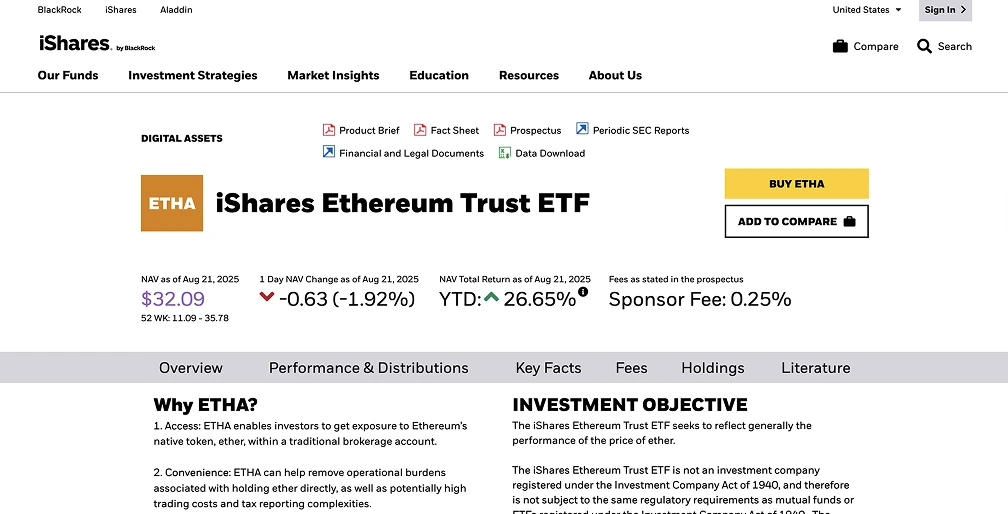
2. Grayscale Ethereum Trust (ETHE): Most Established Ethereum Fund
Launched in 2017, ETHE remains the most recognized Ethereum vehicle. Despite its high 2.5% fee, it manages around $5 billion in AUM. Outflows to lower-cost rivals have pressured Grayscale, prompting a new “Mini Trust” with a 0.15–0.25% promo fee to retain investors.
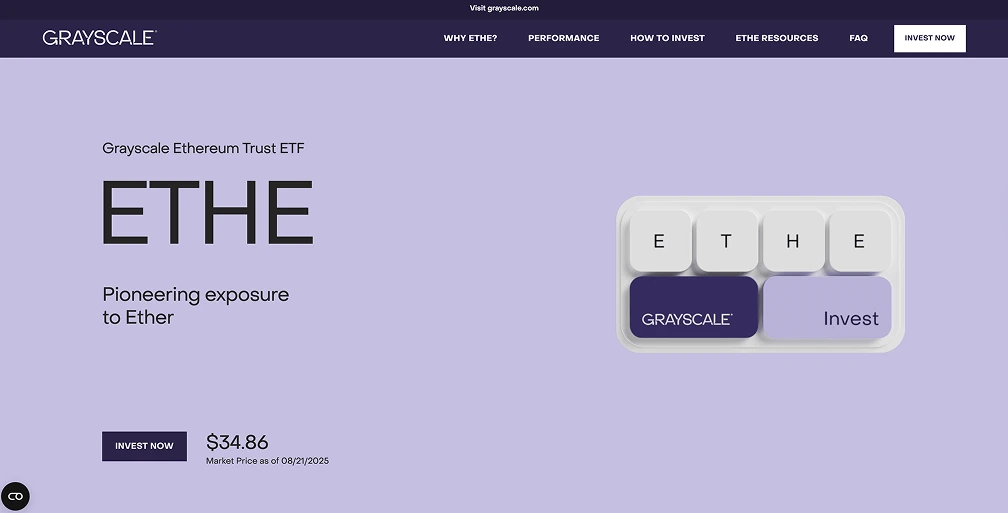
3. Fidelity Ethereum Fund (FETH): Lowest Fee Spot Ethereum ETF
Fidelity’s FETH fund matches BlackRock’s 0.25% sponsor fee, with frequent waivers to attract flows. Its combination of low cost and institutional-grade custody makes it one of the most efficient options for ETH exposure.
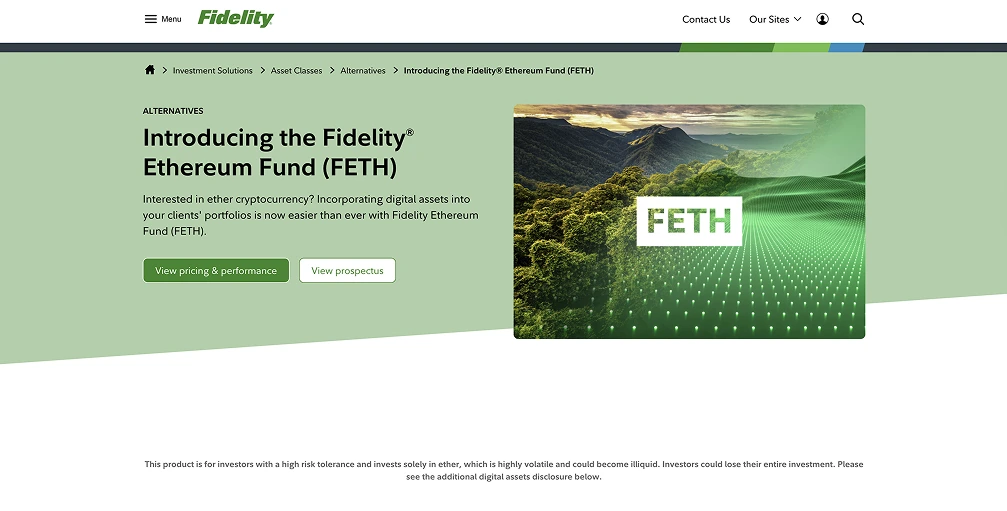
4. VanEck Ethereum ETF (ETHV): Strong Institutional Spot ETF
ETHV is smaller in scale but appeals with ~0.20% fees and a transparent structure. Its competitive pricing and clear framework make it a useful diversification tool for institutional portfolios.
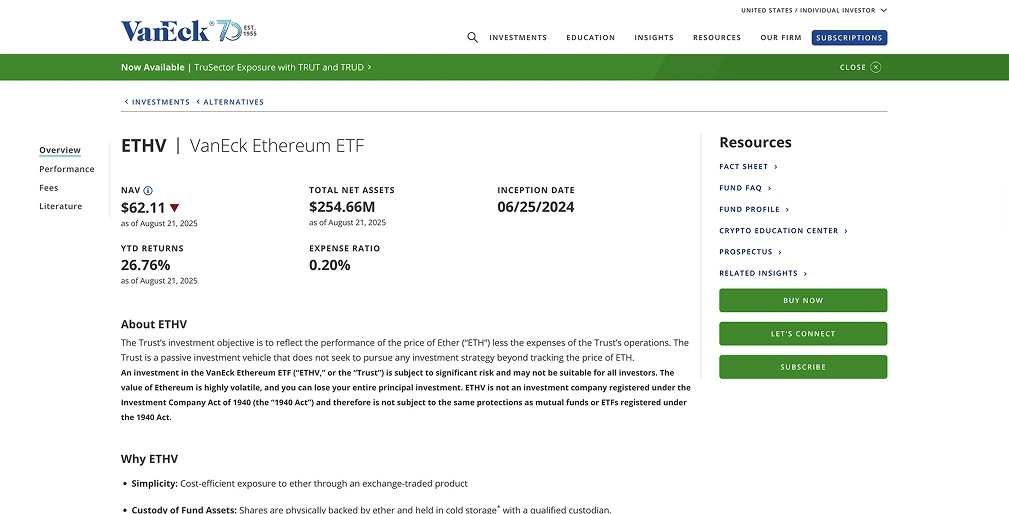
5. ProShares Ether Strategy ETF (EETH): Best Ethereum Futures ETF
EETH invests in CME-traded ETH futures instead of holding ETH directly. With a 0.95% fee, it is the most liquid futures-based option for traders seeking tactical exposure or hedging strategies.
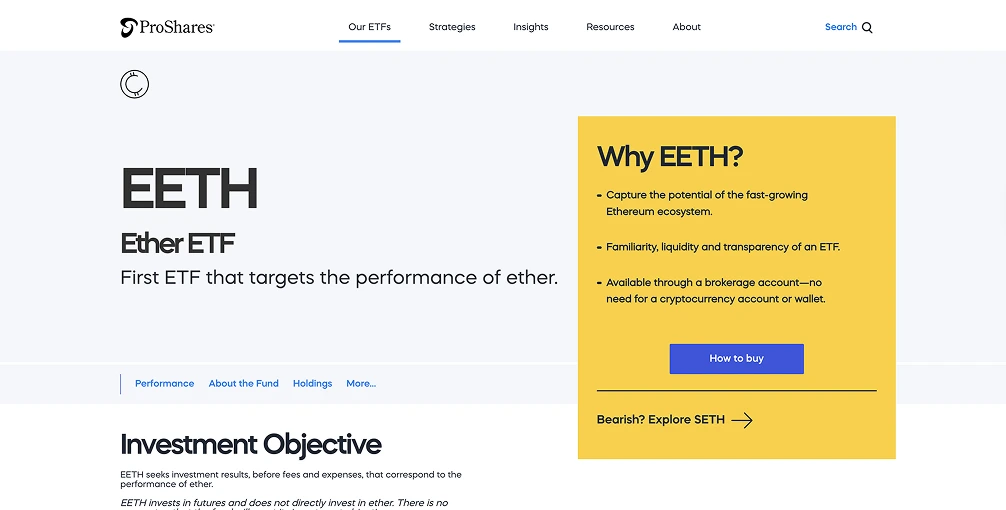
Spot Ethereum ETF vs Futures Ethereum ETF
A spot Ethereum ETF holds ETH directly through a custodian, so its share price tracks Ethereum’s market value. This makes it the most direct and efficient way to gain exposure without managing wallets or private keys. Examples include BlackRock’s iShares Ethereum Trust (ETHA) and Fidelity’s Ethereum Fund (FETH).
A futures Ethereum ETF does not hold ETH. Instead, it uses CME-traded futures contracts to replicate price movements. These funds can face roll costs when contracts expire and may diverge from spot prices. ProShares Ether Strategy ETF (EETH) and VanEck Ethereum Strategy ETF (EFUT) are leading examples.
Spot ETFs suit long-term investors seeking clean price exposure, while futures ETFs are better for traders using short-term strategies or hedging. Futures products may offer liquidity advantages but usually come with higher costs and added volatility.
When Are Staked Ethereum ETFs Launching?
Staked Ethereum ETFs have not yet launched in the United States. Nasdaq recently filed an application with the SEC on behalf of BlackRock’s iShares Ethereum Trust to allow staking of the fund’s underlying ETH. If approved, this would let investors earn staking rewards through the ETF structure while still trading on public exchanges.
The SEC has acknowledged the proposal but has not set a decision date. Its May 2024 guidance classifying staking rewards as income rather than securities transactions opened the door for such products, yet regulatory approval remains the final step.
Until then, staked Ethereum ETFs remain pending, with BlackRock’s filing seen as the most likely first mover.




